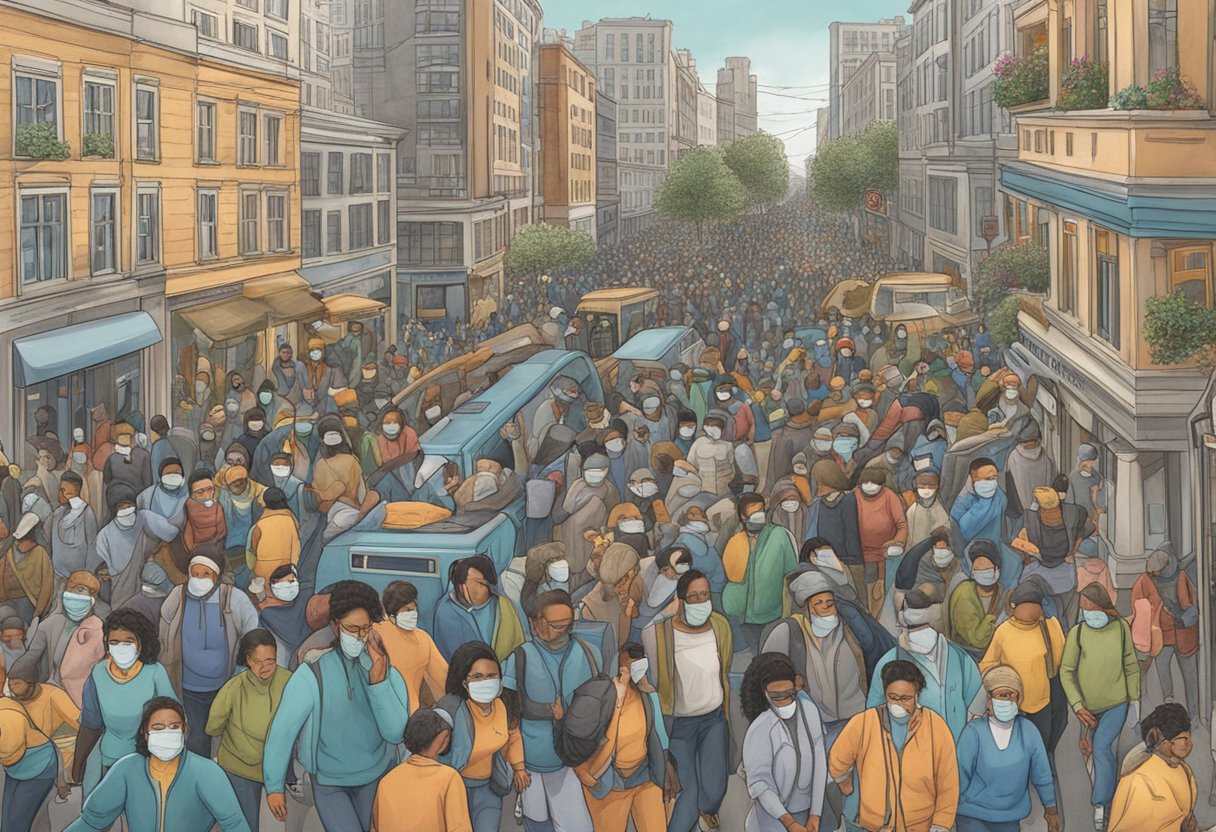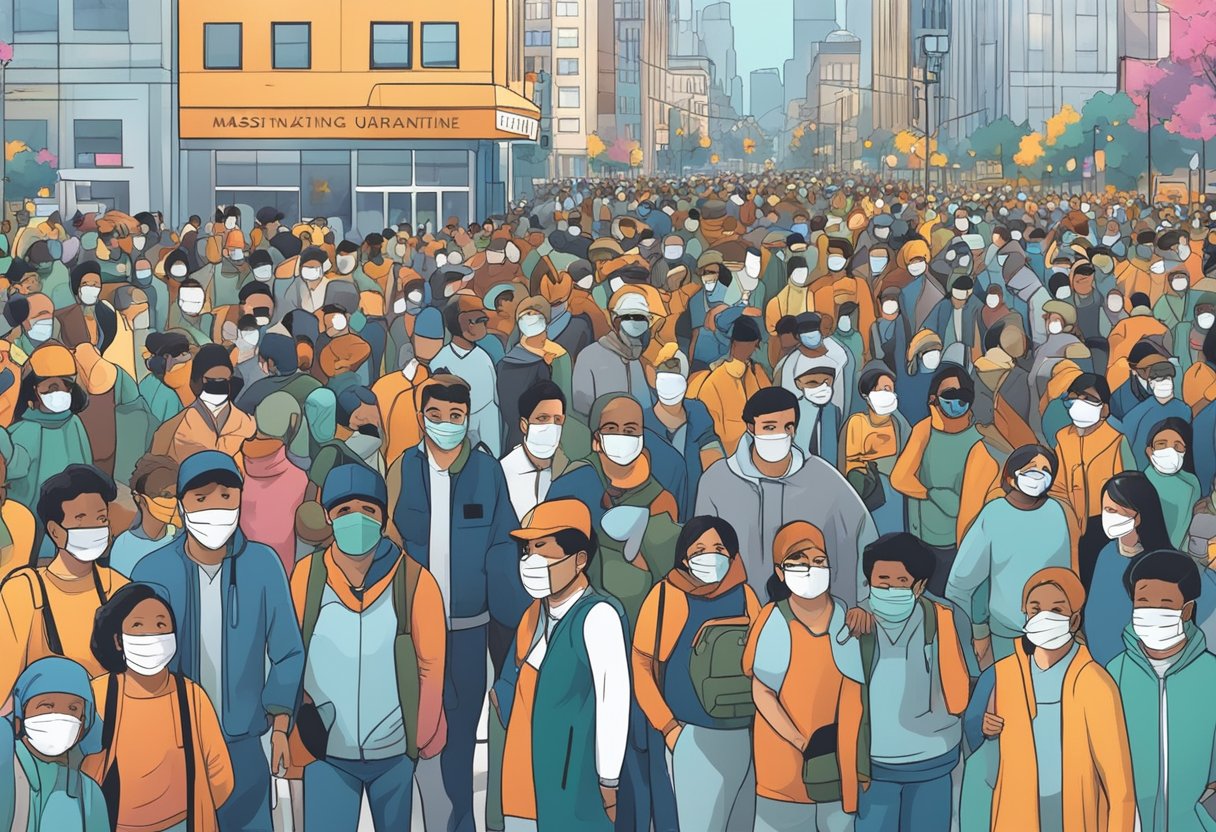The Spanish Flu Pandemic of 1918: Disastrous Lessons for Modern Times

The Spanish Flu pandemic of 1918 remains one of the deadliest outbreaks in human history, affecting the lives of millions across the globe. Originating during the First World War, the influenza virus rapidly spread through Europe, the United States, and beyond, causing widespread devastation. In just over six months, the pandemic claimed the lives of more than 50 million people, stressing medical systems and altering societies in profound ways.
The speed and lethality of the virus overwhelmed hospitals and led to severe social and economic consequences. Public health measures, from quarantine to the use of facemasks, were implemented in a desperate bid to curb the spread. Though some of these measures had limited success, the pandemic highlighted the importance of coordinated public health strategies and the need for scientific advancements.
Modern times present us with new challenges, but the lessons learned from the 1918 Spanish Flu pandemic remain crucial. Understanding these historical events can help societies better prepare for and respond to future pandemics, ensuring we are not caught off-guard by similar health crises again.
The Emergence of the Spanish Flu
The Spanish Flu pandemic of 1918, often termed the deadliest influenza outbreak, began amidst the turmoil of World War I. It infected and killed millions worldwide, spreading in multiple waves and causing catastrophic global effects.
A Brief History
The Spanish Flu emerged in 1918 during World War I. Despite the name, the first cases were recorded in the United States, particularly in Kansas in March 1918. Soldiers in crowded military camps were among the first to contract the virus, which helped it spread rapidly.
As the virus spread, it began to affect various parts of the world. Spain reported high mortality rates early on, thus giving the flu its name. The flu did not discriminate, infecting people of all ages and regions.
The Spring of 1918: The First Wave
The first wave of the influenza pandemic appeared in the spring of 1918. This initial phase was relatively mild compared to the later waves. Communities noticed the illness but did not implement significant measures to combat it.
The virus spread through the movement of troops during World War I, which created ideal conditions for a pandemic. Camps in the United States and Europe saw rapid transmission among soldiers, who then carried the virus to various destinations.
Despite its mild start, this wave set the stage for the subsequent, more lethal phases of the pandemic. The initial spread went largely unnoticed due to the ongoing war, allowing the virus to establish itself.
From Europe to Pandemic: Global Spread
By mid-1918, the influenza virus had spread beyond military camps and began to move globally. Western Europe, particularly France, Britain, and Spain, faced significant outbreaks. The mobility of troops and war refugees facilitated this rapid spread.
Public health measures were few, and many countries were unprepared for the scale of the pandemic. The influenza virus did not spare any region, causing devastating effects worldwide.
The virus quickly moved from Europe to other continents. By July 1918, it had reached as far as Poland and continued to expand. This global spread caused millions of infections and set the stage for the deadlier waves that followed.
The Biological Characteristics of the 1918 Virus

The 1918 influenza virus, known as H1N1, was highly contagious and particularly lethal. It spread rapidly and caused severe illness, leading to a high death toll. The virus's genetic structure and behavior played key roles in its transmission and impact.
Identifying the Strain: H1N1
The 1918 influenza virus was an H1N1 strain. This designation refers to specific proteins on the virus's surface: hemagglutinin (H) and neuraminidase (N). The H1 protein allowed the virus to attach to and enter host cells, while the N1 protein facilitated the release of new viral particles.
The virus's unique H1N1 combination contributed to its virulence. Compared to other strains, it was more adept at infecting humans, leading to widespread outbreaks. Analyzing lung tissue from 1918 victims allowed scientists to reconstruct its genome, revealing why it was so deadly.
Transmission and Virulence
The 1918 H1N1 virus was remarkably contagious, spreading quickly through direct contact, respiratory droplets, and even contaminated surfaces. It could infect healthy adults, which was unusual for influenza viruses, as these typically target the very young, elderly, or immunocompromised.
The virus's high virulence was partly due to its ability to replicate rapidly. Infected individuals experienced severe respiratory symptoms, including pneumonia, which could develop quickly and become lethal. The virus's capacity to weaken the immune system further increased its danger, making secondary infections more common.
Mutations and Immunity Concerns
Mutations in the 1918 H1N1 virus enhanced its ability to infect and cause severe disease. These genetic changes made it difficult for the human immune system to recognize and combat the virus. The rapid mutation rate of H1N1 meant that recovered individuals could still get reinfected, complicating immunity efforts.
The immune response to this virus was also unusually aggressive, sometimes causing a "cytokine storm." This overreaction damaged body tissues and contributed to the high mortality rate. Scientists studying these factors hope to better understand how to manage future pandemics and improve vaccine development.
By focusing on these biological characteristics, one gains insight into why the 1918 H1N1 virus was so devastating and how this knowledge can inform modern scientific and medical practices.
Health Impacts and Symptoms

The Spanish flu pandemic was devastating in its health impacts, from severe respiratory complications to high mortality rates among specific age groups.
Pneumonia and Other Complications
Pneumonia was a significant complication during the Spanish flu pandemic. Many patients developed severe lung infections, often leading to cyanosis, where the skin turned blue due to lack of oxygen. This secondary infection caused many deaths.
Other complications included bacterial lung infections, which worsened the illness. Hospitals were overwhelmed with a surge of patients experiencing severe respiratory distress. These complications made the Spanish flu more deadly compared to other influenza strains.
Demographic Toll: Young Children and Elderly
The Spanish flu took a severe toll on the most vulnerable populations. Young children and the elderly were particularly at risk. Their weaker immune systems struggled to fight the virus. Many children did not survive, and the mortality rate in this group was alarmingly high.
Elderly individuals faced a similar fate, with many succumbing to the virus or secondary infections like pneumonia. This demographic was hit hard, further straining families and healthcare systems.
Morbidity and Mortality Rates
The morbidity and mortality rates during the Spanish flu pandemic were staggering. It is estimated that about one-third of the world’s population was infected. The mortality rate was exceptionally high, with approximately 50 million deaths worldwide.
In the United States alone, around 675,000 people died. High morbidity rates led to overwhelmed hospitals and medical facilities. The death toll affected all aspects of society, from economic productivity to social structures.
This health crisis showcased the severe impact of an uncontrolled pandemic, emphasizing the need for better preparedness and response strategies.
Societal and Public Health Responses

The Spanish Flu pandemic of 1918 caused widespread devastation, leading to significant societal and public health responses. Actions taken included quarantine measures, the adoption of masks, social distancing, and coping with overwhelmed healthcare systems.
Quarantine Measures and Public Discipline
Authorities quickly implemented quarantine measures to limit the spread of the flu. Cities shut down schools, theaters, and places of entertainment. Public gatherings were banned, and people were encouraged to stay at home. Travel restrictions were enforced to prevent the virus from spreading to new areas.
Enforcing quarantines proved challenging. Compliance varied, and some communities experienced tensions. Public discipline was crucial but sometimes inconsistent, affecting the effectiveness of these measures. Despite these struggles, quarantines played a key role in controlling the pandemic's spread.
The Role of Masks and Social Distancing
Masks became a common sight as health officials advised their use. They were made from gauze or other available materials. Communities ran mask-making drives, and advertisements promoted their usage. People wearing masks helped reduce transmission, though their effectiveness depended on factors like material and fit.
Social distancing was another critical measure. People were urged to avoid close contact, maintain physical distance, and limit their interactions. Schools and businesses closed or operated under strict guidelines. This practice helped minimize person-to-person transmission, an essential step in combating the virus.
Impact on Healthcare Systems
The Spanish Flu overwhelmed healthcare systems worldwide. Hospitals filled to capacity, and many turned to makeshift solutions like setting up temporary wards in schools and public buildings. Physicians and healthcare staff worked tirelessly but faced shortages of supplies and medications. The sheer number of patients often left them stretched thin.
Community efforts supported healthcare workers by volunteering and providing resources. Despite these efforts, the pandemic exposed vulnerabilities in healthcare infrastructure. It highlighted the need for better preparedness and resources, lessons that have informed public health strategies ever since.
Concurrent Historical Events

The Spanish flu pandemic of 1918 coincided with World War I, severely influenced by the movements of troops, and significantly impacted the global economy.
World War I and the Spread of Influenza
World War I played a crucial role in the spread of the Spanish flu. The war created conditions like crowded army camps and hospitals. This close contact environment allowed the virus to spread rapidly among soldiers.
The pandemic struck at a time when many countries were already weakened by years of conflict. The war had strained resources and medical infrastructure, making it difficult to respond effectively to the outbreak.
Key Points:
- Overcrowded military camps
- Limited medical supplies
- High infection rates among troops
The Effect Of Troop Movements
Troop movements during World War I facilitated the global spread of the influenza virus. Soldiers traveled from various continents, carrying the virus with them. Infected soldiers boarded ships and trains, which then spread the virus to different parts of the world.
Troops returning from the front lines brought the virus back to their home countries. This led to widespread outbreaks not just in Europe, but globally, affecting millions.
Key Points:
- Global mobility of troops
- Spread through military transport
- Return of infected soldiers to homelands
Economic Disruption and Recovery
The pandemic disrupted economies already weakened by the war. Many industries saw reduced productivity due to high illness and death rates among workers. Army production and manufacturing of essential goods slowed down.
After the war, recovery was slow. Nations had to deal with the dual burden of rebuilding war-torn economies and dealing with the aftermath of the pandemic.
Key Points:
- Reduced labor force
- Slowed industrial production
- Dual burden of war and pandemic recovery
Lessons for Modern Public Health
The Spanish Flu pandemic of 1918 taught many valuable lessons that are still relevant today. These include the importance of vaccine development, understanding how diseases spread, and preparing for future pandemics.
The Development of Vaccines and Antivirals
The 1918 pandemic highlighted the urgent need for effective vaccines and antiviral treatments. Modern science has come a long way, developing vaccines for many infectious diseases. Influenza vaccines are updated annually to match circulating strains. Similarly, the COVID-19 pandemic underscored the importance of rapid vaccine development.
Antivirals, such as Tamiflu for the flu and Remdesivir for COVID-19, help reduce the severity of infections. Investments in research and public health infrastructure are crucial to quickly produce vaccines and antivirals for emerging infectious diseases.
Understanding Epidemiology and Disease Spread
Epidemiology, the study of disease spread, is critical for controlling pandemics. The Spanish Flu showed how fast a virus can travel across the globe. Today, the World Health Organization (WHO) and various national agencies monitor disease outbreaks to quickly respond and contain them.
By tracking the spread of infectious diseases, public health officials can implement measures such as quarantine, travel restrictions, and social distancing. These strategies were vital during the COVID-19 pandemic, helping to slow the spread and reduce the impact on healthcare systems.
Preparedness for Future Pandemics
Preparedness is key to managing future pandemics. Learning from the 1918 Spanish Flu and more recent events like COVID-19, governments and organizations must have plans in place. This includes stockpiling necessary supplies, creating emergency response teams, and conducting regular drills.
Public awareness programs are also essential. Ensuring that communities understand the importance of hygiene, vaccinations, and timely medical care can save lives. Collaborative efforts between nations, supported by bodies like the WHO, help ensure a coordinated global response to any future pandemics.
These lessons form the backbone of modern public health strategies, aiming to protect and improve the health of populations worldwide.
Comparisons with Other Pandemic Events
Examining past pandemics helps to understand the current global health challenges more effectively and to prepare for future infectious disease outbreaks. This section looks at the 1918 Spanish Flu, COVID-19, and the Swine Flu.
Spanish Flu vs. COVID-19
The Spanish Flu killed millions globally in a short period, mainly affecting young adults. COVID-19 mostly impacts older adults, particularly those with comorbidities. The Spanish Flu’s mortality rate reached 8-10% among the 25-40 age group, while COVID-19's general mortality rate is estimated at around 2%.
Both pandemics caused significant societal and economic disruptions. Media coverage played a role in shaping public perception during both events. Just as Spanish newspapers covered the influenza pandemic, modern media continuously updates citizens about COVID-19 developments.
Historical Lessons from Past Epidemics
Understanding the Black Death, the 1918 Flu, and other pandemics offers essential lessons. The Black Death in the 14th century showed the importance of quarantine. The 1918 Flu revealed the need for better healthcare infrastructure and global cooperation.
Past pandemics demonstrated the impact of rapid virus transmission. Virology advances have improved disease detection and vaccine development. These lessons highlight the importance of preparedness and timely response to emerging infectious diseases.
The Swine Flu and Preparedness
The 2009 Swine Flu outbreak was a wake-up call for global health systems. It spread quickly but had a lower mortality rate compared to the Spanish Flu and COVID-19. It mainly affected children and younger adults. The Swine Flu led to improved surveillance systems and vaccine stockpiling. This event highlighted the need for international collaboration and timely public health responses.
Lessons learned from the Swine Flu’s management have been crucial in handling more recent pandemics like COVID-19. With advanced virology, scientists continue to work towards better preparedness for future outbreaks.
Cultural and Social Ramifications
The Spanish Flu of 1918 reshaped society in several profound ways. This section explores how it altered perceptions of health, caused demographic shifts, and influenced cultural outputs like literature and art.
Changing Perceptions of Illness and Health
The Spanish Flu forced people to rethink their ideas about sickness and health. Before the pandemic, many didn’t grasp how quickly diseases could spread. Social distancing and wearing masks became necessary practices. Health systems were overwhelmed, especially in cities, highlighting the need for better public health policies. People started to realize the importance of hygiene and vaccinations to prevent future outbreaks. This led to lasting changes in public health awareness.
Demographic Shifts and Orphans
The pandemic caused significant demographic changes. It affected populations across the world, with many children losing their parents. Camps like Camp Funston in Kansas saw high death rates, leaving many orphans and widows. This increase in orphans strained social services and led to the rise of orphanages and adoption systems. Communities had to support these new orphans, often leading to changes in family dynamics and social structures.
Influence on Literature and Art
The Spanish Flu also left its mark on literature and art. Writers and artists used their works to express the collective trauma and experiences of the pandemic. Many books and paintings from this period reflect the fear, grief, and societal changes that occurred. This cultural output provided a way for people to process their experiences and gave future generations a window into the impact of the pandemic. Through these works, the deep effects of the Spanish Flu on society have been immortalized.
Conclusion
The Spanish Flu pandemic of 1918 highlighted the devastating impact of infectious diseases. The virus spread rapidly across the globe, killing over 50 million people. This pandemic revealed significant weaknesses in public health systems.
This outbreak illustrated the importance of quick and effective communication. Without modern technology, misinformation spread easily, complicating efforts to control the virus. The pandemic also emphasized the need for better medical infrastructure. Overwhelmed hospitals and insufficient medical supplies worsened the situation.
Global cooperation was crucial. Countries needed to share information and resources more effectively to manage the crisis. The lack of coordinated efforts resulted in delayed responses.
Scientific understanding of viruses has since advanced. The knowledge gained from the 1918 pandemic has been instrumental in improving disease surveillance and vaccine development. The socioeconomic consequences of the pandemic were significant. Many businesses closed, and economies suffered. This points to the need for robust economic support systems during health crises.
Today, the lessons from the Spanish Flu remain relevant. Preparedness, quick action, and international collaboration are key to managing future pandemics. Policies implemented now can prevent the enormous loss of life and societal disruption experienced in 1918.




